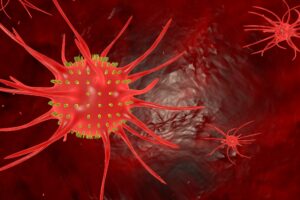
5 Menopause Support Complex Supplement to Help Ease Symptoms
Menopause support complexes are dietary supplements with herbal extracts and vitamins aimed at alleviating symptoms during menopause
Like a key unlocking a door to a secret, understanding neurotransmitters can unlock a much greater understanding of how the brain works. Neurotransmitters are the vital messengers of the brain, controlling and coordinating the activities of our vital organs, muscles, and emotions. In a nutshell, these complex receptors are the building blocks of communication in the body. But what are they, exactly? How do they work? In this post, I’ll demystify neurotransmitters, explaining what they are and how they work in the body. So, buckle up – we’ve got a lot to cover!
Neurotransmitters are the communication pathways between neurons, or nerve cells. They act as messengers that transfer signals from cell to cell, enabling neural networks and the communication within them needed for basic brain functions. Neurotransmitters are chemical substances released into the synaptic cleft of the synapse, the connection between two neurons. They join receptor sites of neighboring neurons and trigger specific responses from those cells. This process is known as neurotransmission and it is vital to most bodily processes, including thought and behavior.
The quantity and type of neurotransmitters released as well as their location can influence how a neuron responds to stimulation. Many researchers debate whether these signals primarily affect someone’s state of mind, or if messages generated by brain activity shape neurotransmitter release itself. Each side proposes its own distinct theories regarding the role of neurotransmitters in motor control, mood regulation, decision-making, and other behaviors linked to the nervous system. While more research is needed to discover which view holds the most truth, one thing is clear: neurotransmitter actions are fundamental components in how our bodies and minds function.
Finally, it is important to consider what structures are involved in transmitting this information between neurons. The key players in this process include receptors, enzymes, transporters, and essential molecules such as ATP (adenosine triphosphate). In the following section, we will discuss how each of these pieces plays a role in effective neurotransmission. Now let’s explore what structural elements are involved in neurotransmission.

Neurotransmission is a dynamic process that relies on multiple structures to work properly. First, the neurons that send and receive messages must be intact and active. Presynaptic neurons contain vesicles filled with neurotransmitters, which are released when stimulated by an electrical or chemical signal from the presynaptic neuron. The synaptic cleft is the space between neurons in which substances like neurotransmitters cross, aiding the release of signals to postsynaptic cells. Once they have crossed the synaptic cleft, neurotransmitters bond to receptors located on postsynaptic cells, where their activity will produce a response within the cell.
The process of neurotransmission is highly variable and can occur through a variety of mechanisms, depending upon the particular composition of the structure involved and its location in relation to other structures in the body. For example, some studies suggest that certain neurotrophic factors secreted by target postsynaptic cells may modulate transmembrane potential changes at presynaptic neurons and thus influence synaptic function. Likewise, neuromodulators such as nitric oxide or endocannabinoids can act on both pre- and postsynaptic sites to regulate neurotransmission. Additionally, glial cells near synapses play a role in eliminating excess neurotransmitter molecules after transmission has occurred. This indicates that there are a range of possible structural components which can aid or interfere with proper neurotransmission processes.
Given all these various structural components involved in neurotransmission, it is essential for scientists to thoroughly understand how all tissues interact in order to effectively characterize this significant biological process. It is important to note however that there is still much debate concerning exactly how all of these structures come together to form a functional system capable of securely transmitting signals between neurons.
Understanding how neurotransmitters work is essential to understanding the biology of behavior. Neurotransmitters are chemical messengers that enable communication between nerve cells in the brain, impacting our mental and physical health. Most neurons have an axon terminal at one end, which releases neurotransmitters into a synaptic cleft or gap junction connecting them to other neurons’ dendrites. Once released, neurotransmitters travel across this synapse, carrying signals from neuron to neuron in the form of electrical pulses. In order for these messages to be sent correctly, it is important that the release of neurotransmitter molecules is regulated and balanced.
Neurotransmitters control many of our most basic physical, psychological, and emotional functions, ranging from memory and emotion regulation to sleep and appetite. Receptors found on receiving neurons interact with these chemical messengers in order to activate an action potential or stimulus response within the cell. The excitatory or inhibitory properties of various neurotransmitters determine whether a message is spread throughout the nervous system or blocked before it can reach its target dendrites.
Once the message arrives at its destination neuron, the interaction between receptors and neurotransmitter molecules can either promote or discourage communication between nerve cells. Excitatory postsynaptic potentials (EPSPs) occur when a substance causes depolarization of post-synaptic membrane; this makes it easier for neurons to fire action potentials or spikes in voltage that pass along information throughout the brain. On the other hand, inhibitory postsynaptic potentials (IPSPs) decrease depolarization and make it harder for signals to pass through a synapse. This balance of excitatory and inhibitory signals helps regulate healthy neurologic functions in our systems.
Overall, understanding how neurotransmitters work is essential in unlocking the secrets of human behavior. These chemicals serve as both a messenger and a regulator of information within our nervous systems, helping us experience emotions and engage in complex motor activities depending on internal stimulus received from within the brain itself or external stimuli received from outside sources. With this knowledge in place, we can begin to explore how these powerful molecules influence our behavior in greater detail—a topic we will dive into further in the next section about: “How do Neurotransmitters Affect Behavior?”
Neurotransmitters are chemical messengers that enable communication between nerve cells, allowing for the regulation of physical, psychological and emotional functions. They can either excite or inhibit postsynaptic potentials depending on the interaction between neurotransmitter molecules and receptors, which influences behavior. Understanding how neurotransmitters work is essential in unlocking the secrets of human behavior and this will be further explored in the following section.

Understanding how neurotransmitters affect behavior is one of the biggest challenges in neuroscience. Neurotransmitters are molecules involved in transmitting electrical signals between neurons and other cells, thereby regulating movement, motivation behavior, cognition, and emotion. By modulating the activity of these neural circuits, neurotransmitters play an integral role in our behavioral functions.
Behavioral effects depend on the type and amount of neurotransmitter present. This affects the balance between excitatory and inhibitory signals sent by neurons to trigger behaviors. Typically, a decrease in excitatory neurotransmitter activity can lead to apathy or depression, while an increase in inhibitory neurotransmitter activity can cause sedation or anxiety. Other reports suggest that even subtle changes in the levels of specific neurotransmitters can make a significant difference in individual behavior.
In addition to altering behavior, neurotransmitters also affect physiological responses such as changes in heart rate, digestion, and more. In fact, some recent studies suggest a direct link between certain reproductive hormones and certain types of behavior associated with social relationships (such as aggression).
Debates about whether neurotransmitters have an effect on behavior have occurred for many years; some researchers argue that other factors may be playing a role in mediating these effects – such as environment or psychological influences. While there is still much work to be done to understand exactly how neurotransmitters are involved in human behavior, it is clear that they do play a role in promoting some psychological processes – including depression, anxiety and other moods – which affect how we behave.
Clearly understanding the intricate interplay between neurotransmitters and behavior requires further research into this complex system. In the next section we’ll look at different types of neurotransmitters and examine their specific behavioral effects.
Neurotransmitters can be divided into two main categories: small-molecule neurotransmitters and neuropeptides. Small-molecule neurotransmitters are small soluble molecules released by vesicles from the synaptic bouton (the structure in the nerve cell where a synapse occurs) that cross the synaptic cleft and bind to receptor proteins on the postsynaptic neuron. Examples of small-molecule neurotransmitters include acetylcholine, noradrenaline, adrenaline, serotonin and dopamine. They are known for their wide range of effects, from muscular contraction to memory consolidation. Neuropeptides are longer chains of amino acids that travel across the synaptic gap to bind to receptor proteins on the postsynaptic neuron. These peptide neurotransmitters can act as neuromodulators—regulating the activity of other neurotransmitter systems—or they can produce direct effects on neurons. Examples of neuropeptides include endorphins, substance P and neuropeptide Y.
While small-molecule neurotransmitters generally act directly within milliseconds after they have been released, neuropeptides tend to have more long-term effects since they function in concert with other hormones or transmitters over hours or even days. Despite this difference in duration, both types of neuronal communication contribute significantly to how the nervous system functions.
Leading into the next section about “Receptor Proteins and Effects of Neurotransmitters”:
For small-molecule and neuropeptide neurotransmission to occur, receptor proteins must be present on the postsynaptic neuron surface. In this next section, we will discuss how these receptors work and what effects different neurotransmitters have upon them.

Receptor proteins are responsible for interpreting the neurotransmitters that have been released into the brain by the sending neuron and transmitting the relevant information to the receiving neuron. These proteins bind selectively with their specific neurotransmitter, allowing them to both interpret and respond accordingly.
The action of a neurotransmitter depends on which type of receptor protein it binds with. Neurotransmitters can either activate or inhibit their corresponding receptor proteins in neurons, leading to an excitatory or inhibitory postsynaptic potential depending on the type of receptors present. Excitatory receptors will produce an action potential when activated, while inhibitory receptors will prevent an action potential from forming when active.
A variety of different types of receptor proteins exist, but they are generally divided into two major categories – ionotropic receptors and metabotropic receptors. Ionotropic receptors act more quickly than metabotropic receptors, releasing ions such as calcium immediately upon activation by the neurotransmitter. Metabotropic receptors, on the other hand, take longer to activate due to their associated signal cascades that must take place. They typically cause a slower synaptic response than ionotropic receptors and can even allow additional neurotransmitters other than the activating messenger to pass through without needing another binding step.
Some people believe that a handful of the neurotransmitters found in the brain can also act on hormones in the body, while others contest this theory. Those who agree argue that these messengers stimulate specific regions of the hypothalamus, causing hormones such as cortisol and adrenaline to be secreted into circulation. On the other hand, those who disagree claim that hormones cannot be manipulated directly by neurotransmitters as any effect that occurs due to environmental stimuli is already regulated by numerous feedback loops throughout our bodies.
Finally, it is important to note that certain drugs can interact with these receptor proteins in order to cause a specific response within cells or organs throughout our bodies. This phenomenon is known as pharmacology and has given rise to countless medical treatments over many years of study and experimentation.
Neurotransmitters are chemical messengers that play a vital role in the functioning of our bodies. They help regulate mood, learning, behavior, and even physical processes like digestion. But how exactly do they work, and what impact do they have on the body?
The key to understanding the impact of neurotransmitters on the body is understanding the way they interact with our hypothalamus and autonomic nervous system. The hypothalamus acts as a central relay station for messages from other parts of the brain. These messages send signals to various parts of the body controlling hormones, muscle tone, heart rate, breathing patterns and metabolism. Our autonomic nervous system also relies heavily on neurotransmitter activity for involuntary bodily functions such as digestion and restful sleep.
There are numerous types of neurotransmitters, including serotonin, GABA, dopamine, and epinephrine. Each type has its own unique task within the body; some act as stimulants while others can induce relaxation or calmness. This balance of neurotransmitter activity helps determine how the body responds to stimuli both internally and externally; it is thought to be responsible for emotional states such as fear and pleasure.
Neurotransmitters can also affect appetite and metabolism. For example, those who suffer from depression often experience an increase in appetite due to the decrease in serotonin levels in their brain, which can lead to weight gain if not properly monitored. Likewise, increased levels of dopamine can aid in improved energy levels and has been seen as beneficial for those with attention deficit disorders or difficulty concentrating due to fatigue.
Although there is much evidence that suggests that neurotransmitters play a key role in our physical and mental wellbeing, there are still many questions unanswered about how exactly they work in the body. The debate rages on between medical researchers who hold varying opinions on this subject: Some believe that we are born with a predetermined set of neurochemicals that never change throughout life; whereas others think that neurotransmitter levels can be influenced by external factors such as stress and diet.
It is clear that neurotransmitters have a profound effect on our health depending on their balance in the body: Too little or too much can potentially lead to issues with mood regulation or other critical bodily functions. While more research is necessary to fully understand their impact, it is certain that understanding neurochemistry can give us valuable insight into our wellbeing.

Neurotransmitters are vital for normal body and brain functioning. They play an important role in communication between the brain and body, working to regulate functions like mood, pleasure, hunger, and sleep. Neurotransmitter imbalance can lead to various mental health issues like depression, anxiety, bipolar disorder, and others.
Treating neurotransmitter imbalances can be challenging, as there is not one single solution. Treatment often involves a combination of lifestyle changes and medications to address specific neurotransmitter deficits or imbalances. In other cases, dietary supplements may help to restore balance or improve energy levels.
One key factor in treating neurotransmitter imbalance is understanding the role of diet in modifying neurotransmission processes in the brain, and the types of foods that can help support healthy functioning. Dietary advice should be individualized according to each patient’s needs, with an emphasis on whole plant-based foods as these tend to be much more nutritious than animal products or processed foods.
It is also helpful to look at non-dietary interventions such as exercise, yoga, breathing techniques and mindfulness practices as a way to support neurotransmitter balance. All of these approaches can have a positive effect on mental well-being by reducing stress levels, improving focus and concentration levels, and promoting relaxation.
The importance of understanding neurotransmitters and how they work cannot be underestimated – it can inform both the preventative and therapeutic approaches used in balancing neurochemistry in different individuals. By taking into account a range of factors that contribute to healthy neurochemical processes – such as diet, lifestyle habits, medications and supplements – mental health professionals can better understand how best to support people with neurochemical imbalances.

The effects of imbalances in neurotransmitter levels on behavior can be significant. Neurotransmitters are responsible for regulating mood, emotions and behavior, so an imbalance in their levels can lead to a wide range of psychological, behavioral and physical issues. For example, imbalances in serotonin and dopamine levels can cause depression, anxiety and mood swings, while imbalances in noradrenaline can cause memory problems or even cognitive decline. Imbalances in these neurotransmitters can also affect appetite, sleep patterns and overall energy levels. Additionally, excess or insufficient amounts of neurotransmitters may hinder the body’s ability to regulate homeostasis, or equilibrium within the body. Ultimately, large fluctuations in neurotransmitter levels could have long-term implications that could significantly affect someone’s overall well-being.
Neurotransmitters are chemical messengers released by neurons in the nervous system that facilitate communication between nerve cells, muscles and glands. They act as the body’s natural electrical and biochemical signals to stimulate muscle movement, regulate mood, and transmit sensory information throughout our nervous systems. In short, neurotransmitters play a crucial role in regulating our thoughts, feelings, movements, and responses to various stimuli.
The number of neurotransmitters present in each neuron varies based on its specific role in the functioning of the nervous system. For instance, dopamine is released during pleasant activities like eating or exercising; serotonin and oxytocin produce positive effects during social interactions; while glutamate helps us learn and remember new things. Neurotransmitters also help control hormone release from glands, ensuring that essential processes like digestion, metabolism and sleep are properly regulated.
In addition to acting as electrical signals, neurotransmitters also act as powerful hormones. Many of these hormones were discovered during scientific research on animals such as rats and mice; they help regulate behaviors like stress-response, emotional states, appetite and satiety among others. Moreover, neurotransmitters also play a significant role in certain types of brain diseases such as anxiety disorders or depression by modifying the emotional state of an individual through their release of hormones.
Although there is much more to be discovered about neurotransmitters and their role in the functioning of the nervous system—there is no doubt that they form an integral part of regulating many physiological processes including sensation, movement, emotion and cognitive function.
Neurotransmitters are chemical messengers that transmit information from one neuron to another by crossing the synaptic gap between them. Neurotransmitters, such as serotonin and dopamine, travel across the space between neurons, called a synapse, and bind to special receptors on the next neuron in line. Once there, they trigger changes in the neuron’s ability to transfer signals and cause it to either become more or less active in sending and receiving messages. This process of neurotransmission is necessary for communication between neurons so that they can accurately relay information throughout the body.

Menopause support complexes are dietary supplements with herbal extracts and vitamins aimed at alleviating symptoms during menopause

Vitamin C, D3, Zinc, and Quercetin support immune health. They enhance immune cell function, fight infections, reduce inflammation, and provide antioxidant benefits.

Ginseng, a valued herb with adaptogenic and antioxidant properties, is popular as a supplement for improved well-being, energy, and immune function.

Nootropic supplements enhance focus, memory, and cognitive function. They boost mental clarity, motivation, and creativity for improved performance and brain health.

Garcinia cambogia, a tropical fruit, is touted for weight loss. Its active ingredient, HCA, may inhibit fat formation, but evidence is limited. Consult a professional before use.

More and more people are jumping on the mushroom supplement bandwagon these days, but you should be aware that there are potential side effects you should know about before taking the plunge. Whether you’re begging for overall well being or looking for an extra performance boost, you’re going to want to make sure you’re making an informed decision before adding mushroom supplements to your daily routine. We’ve put together a list of potential side effects to look out for, so read on and learn the truth before you start popping those pills.

Moringa, the “miracle tree,” offers numerous benefits. Moringa supplements provide essential nutrients, antioxidants, anti-inflammatory effects, and potential blood sugar and cholesterol regulation. They support immunity and combat malnutrition, but medical advice is essential.

It’s a good thing that Mother Nature both created and found cures for many of the ailments we humans suffer from. From the common cold to serious diseases, herbs have the potential to not only alleviate symptoms, but to completely prevent illnesses in the first place! Herbal remedies for immune system support have become increasingly popular as natural ways to boost your immunity against illness start to catch on.
